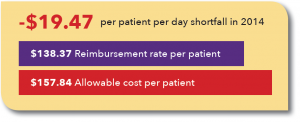The 85th Legislature should pass the Nursing Facility Reinvestment Allowance.
For the past 15 years, the state’s Medicaid reimbursement rate for nursing homes has failed to cover the cost of care per patient. This has kept wages down, made reinvestment into capitol improvements difficult and generally put a strain on Texas nursing homes that can be seen in the quality ratings cited for the state’s long term care facilities.
DETRIMENTAL EFFECTS AND IRREPARABLE HARM
 While Texas nursing homes continue to do more with less, a recent study by the Bonadio Group and COPE Health Solutions reinforces the link between a state's Medicaid reimbursement rate and the quality of its long term care. The study concludes that if he trend of underfunding continues, "there could be serious detrimental effects resulting in irreparable harm to the nursing home industry within the state’s efforts to reverse the negative trend in staff turnover and retention, and ultimately patient care."
While Texas nursing homes continue to do more with less, a recent study by the Bonadio Group and COPE Health Solutions reinforces the link between a state's Medicaid reimbursement rate and the quality of its long term care. The study concludes that if he trend of underfunding continues, "there could be serious detrimental effects resulting in irreparable harm to the nursing home industry within the state’s efforts to reverse the negative trend in staff turnover and retention, and ultimately patient care."
UNABLE TO INVEST IN CARE IMPROVEMENTS
 One of the lowest reimbursement rates in the country makes it impossible for facility owners to upgrade homes, build necessary infrastructure, implement cutting edge technology, provide programs for residents and maintain a skilled workforce.
One of the lowest reimbursement rates in the country makes it impossible for facility owners to upgrade homes, build necessary infrastructure, implement cutting edge technology, provide programs for residents and maintain a skilled workforce.
Other financial pressures are compounding the consequences of recurring shortfalls. The state’s rollout of Medicaid Managed Care has caused costly payment delays from health plans and increased costs to manage the added reimbursement processes and responsibilities. Federal regulations, such as the employer mandate of the Affordable Care Act (ACA) have added to costs as well and are not reimbursed by the state Medicaid rate.
 For nursing home providers, this means it is often difficult to pay competitive wages. They struggle to recruit and retain quality nurses and nurse assistants. As a result, they often have trouble keeping their facilities fully staffed and see some of their best caregivers leave for more lucrative jobs outside long term care. In the end, elderly Texans relying on nursing care feel the consequences.
For nursing home providers, this means it is often difficult to pay competitive wages. They struggle to recruit and retain quality nurses and nurse assistants. As a result, they often have trouble keeping their facilities fully staffed and see some of their best caregivers leave for more lucrative jobs outside long term care. In the end, elderly Texans relying on nursing care feel the consequences.
A GROWING PROBLEM GETTING WORSE
 The funding gap is a serious problem for the state’s long term care providers that may only get worse as a rapidly growing number of seniors with increasingly complex medical needs begin to require care in nursing facilities over the next five to 10 years. Nursing homes in rural and other under-served areas may be harder to find and quality of care harder to maintain.
The funding gap is a serious problem for the state’s long term care providers that may only get worse as a rapidly growing number of seniors with increasingly complex medical needs begin to require care in nursing facilities over the next five to 10 years. Nursing homes in rural and other under-served areas may be harder to find and quality of care harder to maintain.
All of this affects a facility’s ability to improve resident quality of life and encourage resident independence with daily living activities, so important to an individual’s well-being. Without a substantial increase in the state’s Medicaid reimbursement rate, alternative funding options must be provided to improve the quality of nursing home care and avoid a collapse of the state’s long term care safety net.
SUPPLEMENTING NURSING HOME REIMBURSEMENTS WITHOUT STATE FUNDING
A Nursing Facility Reinvestment Allowance should be implemented to supplement the state’s Medicaid reimbursement rate by drawing down additional Medicaid funding from the federal government without the use of state funds. This solution would have no effect on the state’s general revenue but would provide much-needed funding to address the significant Medicaid reimbursement shortfall, and advance the efforts to improve quality care delivery in communities across Texas. The solution would not expand the number of people eligible for Medicaid and the costs could not be passed on to private pay residents. The NFRA concept mirrors the existing program initiated by HHSC to augment funding for the state’s intellectual and developmental disability services.

